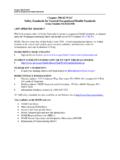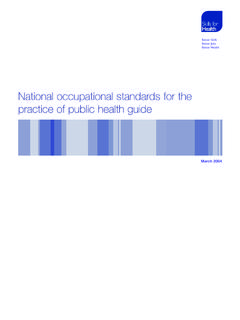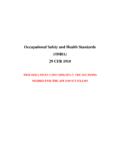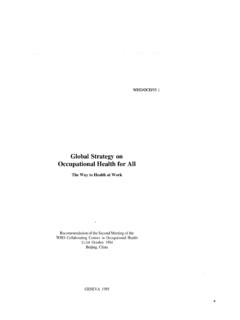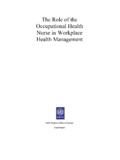Transcription of Occupational health standards in the construction industry
1 health and Safety Executive Occupational health standards in the construction industry Prepared by the health and Safety Laboratory for the health and Safety Executive 2007 RR584 Research Report health and Safety Executive Occupational health standards in the construction industry Anil Adisesh, Roger Rawbone Jacqui Foxlow & Jo Harris Roberts health Improvement Group health and Safety Laboratory Harpur Hill Buxton SK17 9JN HSE estimates that 2,000,000 people within the UK currently suffer from an illness caused by, or made worse by the working environment. Ill health can have a significant impact on the productivity of a business sickness absence costs the UK economy an estimated 12 billion per annum. In 2005/2006 the construction industry had the second highest rate of self reported illness attributed to work at 3,800 cases per 100,000 employed persons ( health and Safety statistics 2005/06 HSE Books 2006).
2 construction workers have a high overall mortality rate, independent of social class, with bricklayers and labourers being recorded as having the second highest mortality rate (Snashall, 2005). This report and the work it describes were funded by the health and Safety Executive (HSE). Its contents, including any opinions and/or conclusions expressed, are those of the author alone and do not necessarily reflect HSE policy. HSE Books Crown copyright 2007 First published 2007 All rights reserved. No part of this publication may be reproduced, stored in a retrieval system, or transmitted in any form or by any means (electronic, mechanical, photocopying, recording or otherwise) without the prior written permission of the copyright owner. Applications for reproduction should be made in writing to: Licensing Division, Her Majesty s Stationery Office, St Clements House, 2 16 Colegate, Norwich NR3 1BQ or by e mail to hmsolicensing@cabinet ii CONTENTS 1 Occupational 2 MINIMUM COMPETENCES FOR Occupational health Occupational health Occupational health Occupational health Technicians.
3 3 3 Occupational health SERVICE PROVISION ..5 health and Safety Policy ..5 Occupational health Referral ..6 Pre-placement Statutory Heath 4 MINIMUM health SURVEILLANCE standards FOR THE construction Hand-Arm Vibration Noise-Induced Skin Disorders ..14 Respiratory Disease ..15 Musculo-Skeletal Work-related stress ..19 5 SAFETY-CRITICAL Recommendation for applicability of standards for safety critical work to construction workers ..21 Visual Acuity Recommendation for Hearing standards for safety critical construction Re-assessment of fitness for safety critical Recommendation for re-assessment of fitness for safety critical work for construction workers ..24 Drugs and Alcohol ..24 Vocational 6 ETHICAL AND LEGAL Scope ..27 Storage of personal Occupational health data an Data Protection Medical data.
4 32 Issues for Pre-employment 7 8 MATRIX ..36 iii iv ACKNOWLEDGEMENTS We would like to thank Sue Parkyn, Michelle Aldous, John Osman, Dil Sen and Jacqueline Halliday-Bell for their help in researching Occupational health standards in the construction industry . v vi EXECUTIVE SUMMARY Objectives To identify the minimum standards for Occupational health provision within the construction sector and how these may form the basis of a national database which aims to facilitate Occupational health provision for workers who move between employers. Main Findings The construction sector is a complex environment as both the workplace and the workforce are non-static. Nonetheless, there are common requirements of health and Safety legislation and objectives for Occupational disease reduction.
5 The core elements of Occupational health provision were identified and recommendations were made for health monitoring / surveillance of the main Occupational conditions affecting the construction sector. The nature of the information to be collated means that the provisions of the Data Protection Act 1998, with regard to sensitive personal data will need to be accommodated. There are also ethical issues, which have been highlighted in this report and will require further discussion with the relevant stakeholders. Recommendations Minimum standards for Occupational health providers should be adopted. construction employers should have policies which relate not only to safety but also Occupational health strategy and provision Appropriate procedures should be adopted for the pre-placement confirmation of employee fitness Minimum standards are advised for health monitoring / surveillance for Hand Arm Vibration Syndrome, Noise Induced Hearing Loss, dermatitis, Respiratory disease (sensitisers, Silicosis and Chronic Obstructive Pulmonary Disease), Musculoskeletal problems and Stress.
6 Minimum standards for Safety Critical Work are advised Consideration should be given to the legal and ethical issues identified in establishing a national database for the construction sector. vii viii 1 Occupational health HSE estimates that 2,000,000 people within the UK currently suffer from an illness caused by, or made worse by the working environment. Ill- health can have a significant impact on the productivity of a business sickness absence costs the UK economy an estimated 12 billion per annum. In 2005/2006 the construction industry had the second highest rate of self reported illness attributed to work at 3,800 cases per 100,000 employed persons ( health and Safety statistics 2005/06 HSE Books 2006). construction workers have a high overall mortality rate, independent of social class, with bricklayers and labourers being recorded as having the second highest mortality rate (Snashall, 2005).
7 Occupational health considers the effect that work may have on health and the effect that health can have on work. It aims to prevent ill health rather than cure it and focuses on: The protection and promotion of the health of workers by preventing and controlling Occupational diseases and accidents and by eliminating Occupational factors and conditions hazardous to health and safety at work. The development and promotion of healthy and safe work, work environments and work organisations. The enablement of workers to conduct socially and economically productive lives and to contribute positively to sustainable development. (based on WHO, 1994) 1 2 MINIMUM COMPETENCES FOR Occupational health PROVIDERS The Management of health and Safety at Work Regulations 1999 (MHSW) state that, employers who appoint doctors, nurses or other health professionals to advise them of the effects of work on employee health , or to carry out certain procedures, for example, health surveillance, should first check that the providers can offer evidence of sufficient level of expertise or training in Occupational health .
8 This is reinforced by the health Surveillance at Work Guidance (HSG 61, HSE Books) which states that it is the duty of the employer to provide health surveillance for those employees considered at risk and that it is essential that the people who carry out health surveillance are competent to do so. The competence required will depend on the tasks performed and specific standards can be found within guidance associated with regulations. When appointing either an Occupational doctor or an Occupational health nurse, their registration/personal identification number (PIN) should be obtained, and confirmed with the appropriate governing body. For doctors, the General Medical Council (GMC) website ( ) will provide information relating to the individuals registration and fitness to practice and the Faculty of Occupational Medicine (FOM), ( ) will be able to confirm their Occupational health qualification.
9 For nurses, the Nursing and Midwifery Council (NMC) website, ( ), will allow you to confirm the individuals registration and qualification details. Occupational health DOCTORS Occupational health doctors are required by law to possess skills and expertise including an understanding of the health hazards that can arise at work, the ability to assess risks relating to the health of individuals and groups, knowledge of the law relating to workplace issues and an awareness and understanding of the way business operates. There are currently three levels of qualification in Occupational medicine for doctors, the Diploma in Occupational Medicine ( ) the Associateship of the Faculty of Occupational Medicine (AFOM) Membership of the Faculty (MFOM). In addition, the Fellowship of the Faculty (FFOM) is awarded to those Occupational physicians with MFOM who have made a distinguished contribution to the specialty and who demonstrate a greater depth of experience and expertise in Occupational medicine.
10 Doctors without these qualifications who rely solely on experience gained in the workplace may not meet the requirements for competence that are demanded by many aspects of health and safety legislation. Therefore, it is recommended that the Diploma in Occupational Medicine be used as the minimum standard for the construction industry . However, individuals should work within the limits of their competence and be cognisant of the need to access specialist Occupational physician advice as needed. The level of Occupational health expertise will need to be commensurate with the level of health risk identified for the project for a complex construction project it would be usual for the Occupational health provision to be led by a consultant Occupational health physician. The Faculty of Occupational Medicine ( ) can confirm the qualifications and specialist status of a member.










